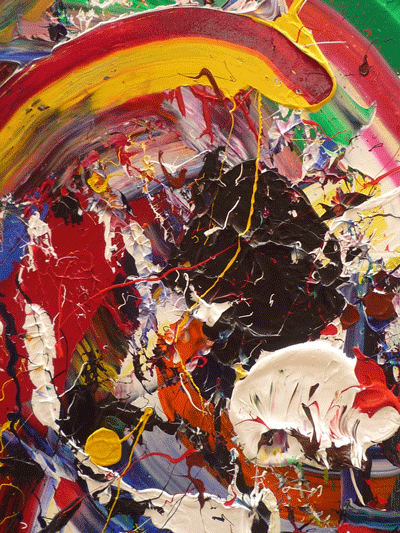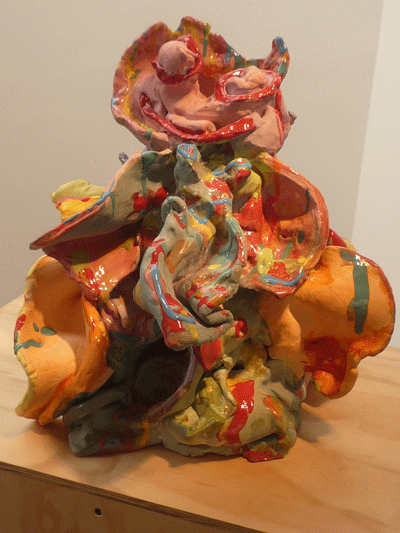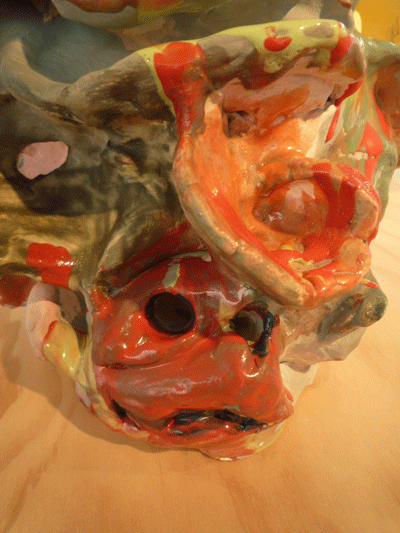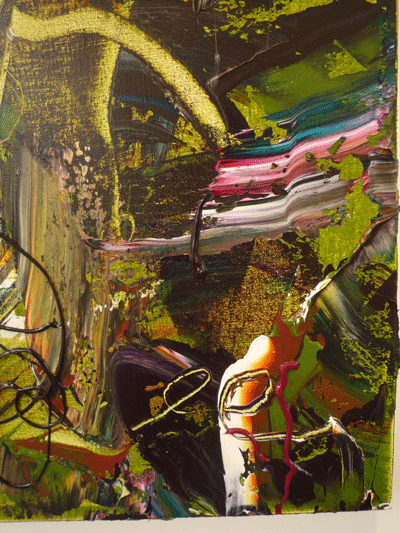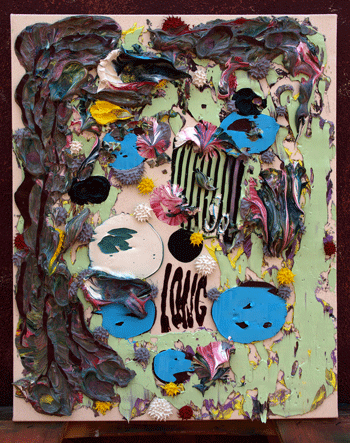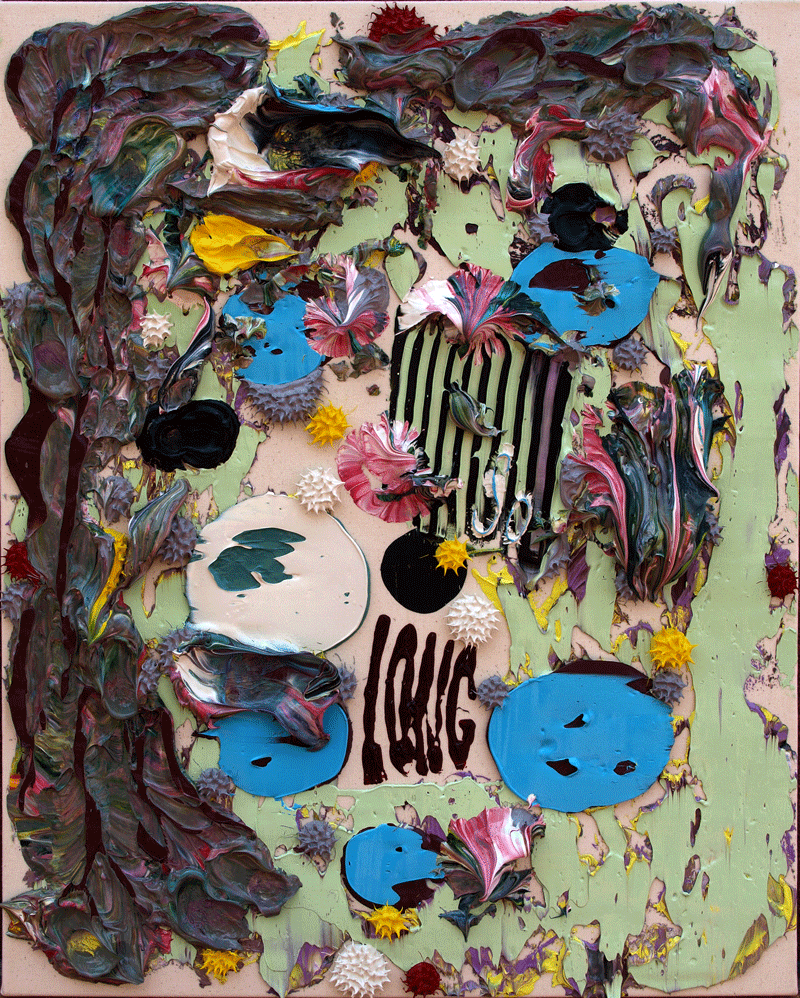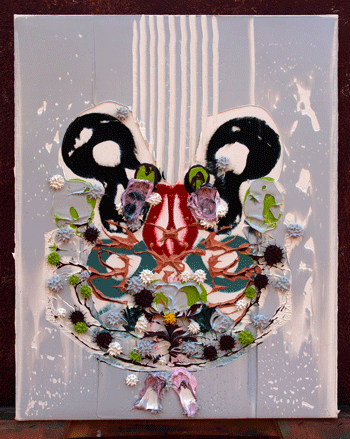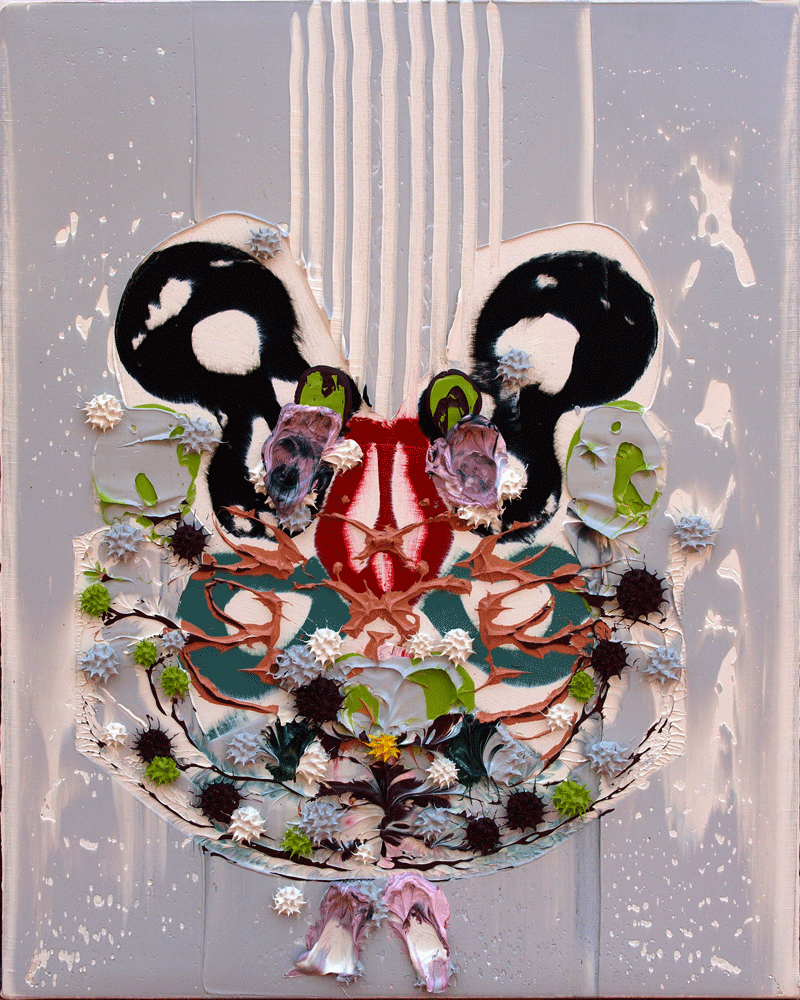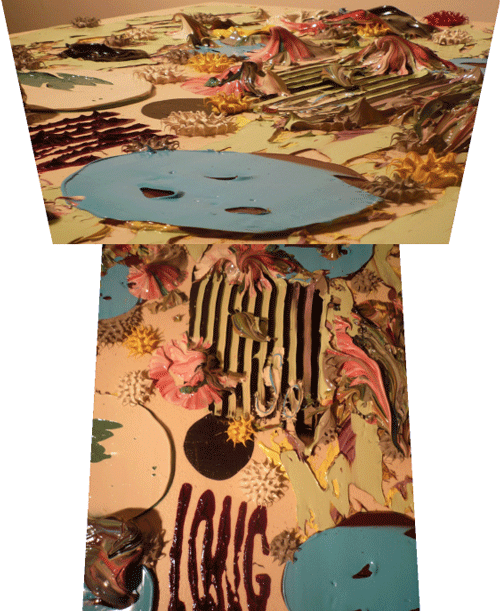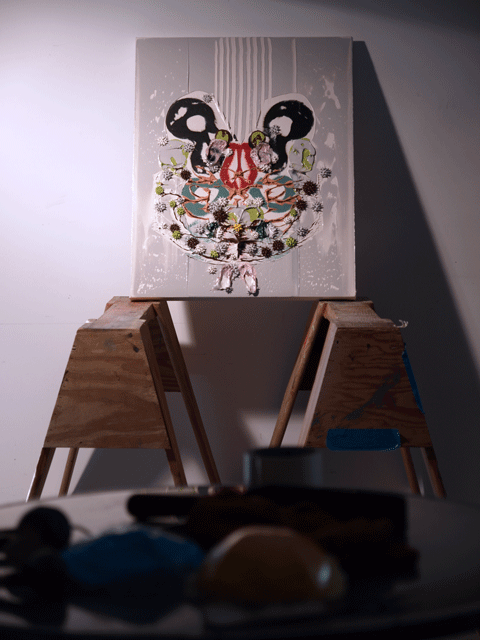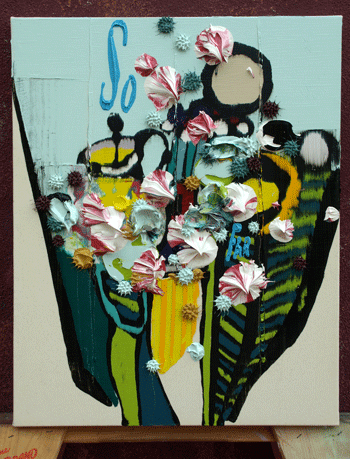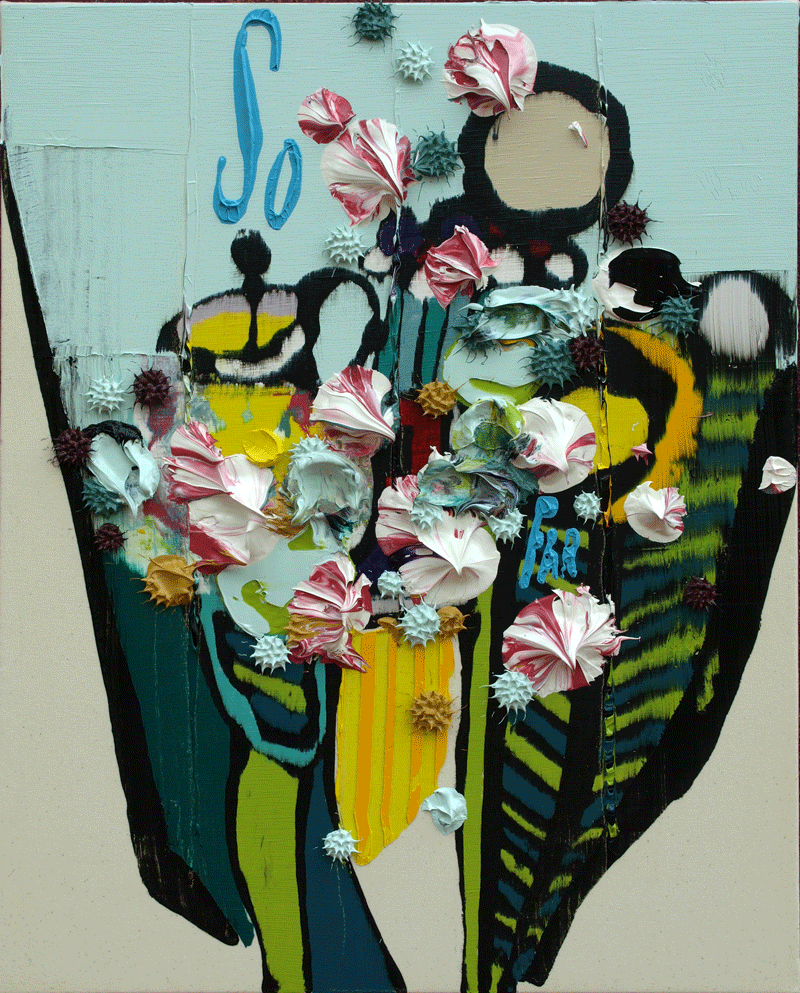April 28, 2010
pull, my little ones
I've been listening to LibriVox's recording of Melville's Moby-Dick. The reader is not the best voice actor but that's what you get for free and after the first few lines, as in any story read aloud, the reader's voice dissolves into the literature soon enough. I've read it many years ago, and it made a great impression on me of course. My ye olde Navy days reverberates in the novel to good effect. And why am I reencountering this classic? Just following my nose, I guess. I've had many a good experience doing just that.
Among the many dimensions that shine like jewels in Melville's work, are the moments when the headsmen of the harpooner's boats communicate with their crew. Stubb's style is particularly funny. All in all, the book reminds me of all the unique personalities I met at sea so many years ago.
The cadence call to the oarsmen also takes my mind to my fellow artists around the world breaking backs against the gunnels of our studios.
Here's a slice, me hearties:
CHAPTER 48
The First Lowering
"Pull, pull, my fine hearts-alive; pull, my children;
pull, my little ones," drawlingly and soothingly sighed Stubb
to his crew, some of whom still showed signs of uneasiness.
"Why don't you break your backbones, my boys? What is it you stare at?
Those chaps in yonder boat? Tut! They are only five more hands
come to help us never mind from where the more the merrier.
Pull, then, do pull; never mind the brimstone devils are good
fellows enough. So, so; there you are now; that's the stroke
for a thousand pounds; that's the stroke to sweep the stakes!
Hurrah for the gold cup of sperm oil, my heroes!
Three cheers, men--all hearts alive! Easy, easy; don't be in a hurry--
don't be in a hurry. Why don't you snap your oars, you rascals?
Bite something, you dogs! So, so, so, then:--softly, softly!
That's it--that's it! long and strong. Give way there, give way!
The devil fetch ye, ye ragamuffin rapscallions; ye are all asleep.
Stop snoring, ye sleepers, and pull. Pull, will ye? pull,
can't ye? pull, won't ye? Why in the name of gudgeons and
ginger-cakes don't ye pull?--pull and break something! pull,
and start your eyes out! Here," whipping out the sharp knife
from his girdle; "every mother's son of ye draw his knife,
and pull with the blade between his teeth. That's it--that's it.
Now ye do something; that looks like it, my steel-bits. Start her--
start her, my silverspoons! Start her, marling-spikes!"Stubb's exordium to his crew is given here at large,
because he had rather a peculiar way of talking to them in general,
and especially in inculcating the religion of rowing.
But you must not suppose from this specimen of his sermonizings
that he ever flew into downright passions with his congregation.
Not at all; and therein consisted his chief peculiarity.
He would say the most terrific things to his crew, in a tone
so strangely compounded of fun and fury, and the fury seemed
so calculated merely as a spice to the fun, that no oarsman
could hear such queer invocations without pulling for
dear life, and yet pulling for the mere joke of the thing.
Besides he all the time looked so easy and indolent himself,
so loungingly managed his steering-oar, and so broadly gaped--
open-mouthed at times--that the mere sight of such a yawning commander,
by sheer force of contrast, acted like a charm upon the crew.
Then again, Stubb was one of those odd sort of humorists,
whose jollity is sometimes so curiously ambiguous, as to put
all inferiors on their guard in the matter of obeying them....How different the loud little King-Post. "Sing out and
"Look at that chap now," philosophically drawled Stubb, who, with his
say something, my hearties. Roar and pull, my thunderbolts!
Beach me, beach me on their black backs, boys; only do that for me,
and I'll sign over to you my Martha's Vineyard plantation, boys;
including wife and children, boys. Lay me on--lay me on!
O Lord, Lord! but I shall go stark, staring mad! See! see that
white water!" And so shouting, he pulled his hat from his head,
and stamped up and down on it; then picking it up, flirted it
far off upon the sea; and finally fell to rearing and plunging
in the boat's stern like a crazed colt from the prairie.
unlighted short pipe, mechanically retained between his teeth,
at a short distance, followed after--"He's got fits, that Flask has.
Fits? yes, give him fits--that's the very word--pitch fits into 'em.
Merrily, merrily, hearts-alive. Pudding for supper, you know;--
merry's the word. Pull, babes--pull, sucklings--pull, all.
But what the devil are you hurrying about? Softly, softly,
and steadily, my men. Only pull, and keep pulling; nothing more.
Crack all your backbones, and bite your knives in two--that's all.
Take it easy--why don't ye take it easy, I say, and burst all your
livers and lungs!"
April 26, 2010
Post Script
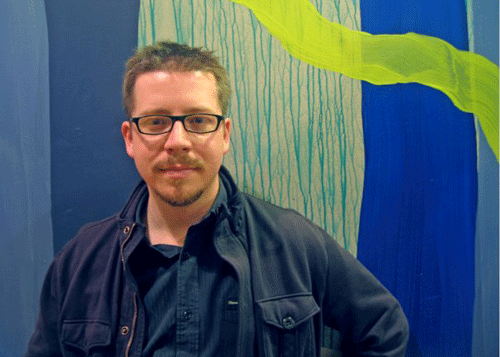
Quinton Bemiller brought a group of artists for a studio visit last Saturday. It was the second such studio visit that I've had this spring, and I have another speaking engagement as a guest artist lecturer for Monique van Genderen's advanced painting class at UCLA next week.
Public speaking both thrills and scares me. I immediately think of skydiving, the stomach wrenching feeling is the same. And yes, I have had the skydiver experience once in my college days. Once, that is. I wanted the thrill of the experience but skydiving is the kind of sport where only complete devotion might insure you from horrific and sudden death. This is the key where the odds of survival diminish with each successive jump. Public speaking is different, the odds of success are reversed in fact. For me, public speaking is similar to skydiving in terms of gut sensation.
Now that I think of it, actors do die onstage at times.
One would think that my previous experience as an adjunct professor (architecture, Woodbury University, Burbank, 1992-2000) would have armored me in this respect. Not in my case. An audience which consists of a class of 15 or so students was intimidating at first. I soon discovered two solutions. After a brief introduction of myself and the class content, I would ask each student to introduce themselves, thus allowing me to delve into each character and assess the class potential overall. Secondly, I realized that by announcing an assignment, any anxiety (mine, that is) would be instantly transferred to the students (in the best sense) and the task of transmitting curricula content would be grappled forthwith.
Neither of these two solutions works for a studio visit, however. Generally, I remember that a good start in public speaking involves a protocol of gratitude. Thanks for the invitation, thanks for the audience. Such expressions I usually find easy to come by, too easy that is. Effusion is a weakness of mine, I try to govern it. The icebreaker-of-humor technique is another tool that I repeatedly leave abandoned in the toolbox. The icebreaker joke or humorous story conveys a tone of geniality, it is a window into what the audience are about to hear. I am not a natural joke teller, unfortunately. How does one go about learning such a thing?
I feel that this blog is an instrument that is as yet underutilized by me. There is much that falls through the editorial cracks. Maybe it is because constantly discerning private from public information is difficult in the art world. It is certainly because the perfect ideal of blogging would be a minute to minute account of one's impressions and ruminations. This is a blogger's utopia that approaches disease. I perform far short of this ideal, but in general, I suppose that I should be more energetic all the same. This blog as a record of my curiosities, as a testament of the life in my studio both mental and physical in terms of the connections of one to the other, and this places no small stress to the efficacy of my project overall. Therefore I promise myself and you, dear reader, to do better in the future. But a blog is good for post scripting life, too.
Here is what I would have liked to have said at the outset of Quentin's class visit:
Quentin, thanks for bringing an audience to me. (This, I did say. But I could have modeled my gratitude much more vividly.) There is an overarching importance of the audience in art, one that deserves much more recognition. Maybe it is because what most artists do is intrinsically new or out of the general discourse that we are accustomed to smaller audiences... and perhaps we artists unconsciously tend to jump to the assumption that the cognoscenti are the natural, best audience and are therefore naturally limited in number. "So what if few appreciate my work, soon many and all might." This is too easy a formulation. Let us say that for the sake of argument, that perhaps an artist's task is to reduce and perhaps eliminate doubt. Wouldn't it be best to seek out as much of an audience as possible and appeal to all their senses for the sake of our work? Thanks therfore to Quentin for bringing these people to my studio, and thanks to his students who have troubled themselves to insert me into their schedule to see the work and listen to what I might say about it.
There is something to be praised about the uniqueness of Quenton's project: his entrepreneurialism, the manifestation of the extra-academic, and public service.
Quentin evolved his roving art tours from the creation of a painting class in the public realm. As he tells the story, he started to assign galleries for his students to visit and report on what they saw in the subsequent class. All too often, life would run interference and the field work would come lacking, so he just took them out to see the art he felt they needed exposure to. Our art world is a big place and soon the field trips took on a life of their own, spawning a second line of work for him. Business, in other words. Entrepreneurialism in other words. It is sometimes strange to me that so much of Marx infuses the theory and philosophy of life in our art world, especially since the literal reality of an artist's life is that of a self starting small business. Marcel Duchamp worked in the secondary market to finance his shenanigans. Both aspects of his life are essentially entrepreneurial. Damian Hirst and all of his ilk (I call them CEO artists because they are arch conceptualists who specialize in the art of the deal) spin off lisencees, restaurants, bars and discos... But I am starting to digress. No matter, this is another topic and a huge one at that, destined for future blog post. Suffice it to say that what Quentin is doing is in the best sense of the term, entrepreneurial, and should be applauded by artists of all stripes.
Quentin created a painting class, folks. I know that this has been done before, but what he is doing is on or near the level of a graduate painting class one could find in any of our university fine art departments across the country. Think of it: might there exist a market in a similar class in... sculpture? Art history? Theory? Performance? Film and video? Wouldn't it be great if art school as we know it found a life outside of the campus and in the world at large? Art School Gone Wild?
As such, what Quentin is doing is a public service as much as he pays his bills. He brought together a bouquet of like minded people and presented them to me with much grace. Let us take to his example and may a thousand flowers bloom.
April 24, 2010
April 22, 2010
April 19, 2010
For Lease Downtown

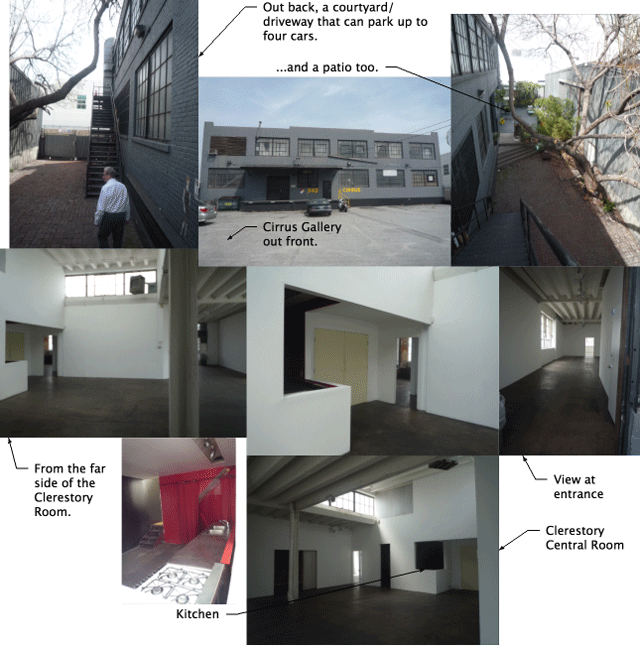
Jean Milant called the other day asking if I knew anyone who would want to lease a space in his building, also the location of Cirrus Gallery, located off Alameda in downtown Los Angeles.
And here we are.
The Stats: 3000 sf for $3300/mo. Parking for four small cars, three if they're large. A central clerestoried space rimmed by rooms, lots of them.
What kind of space is it? It's a creative work space, naturally.
April 17, 2010
Sneak Peek: Bart Exposito at Tom Solomon
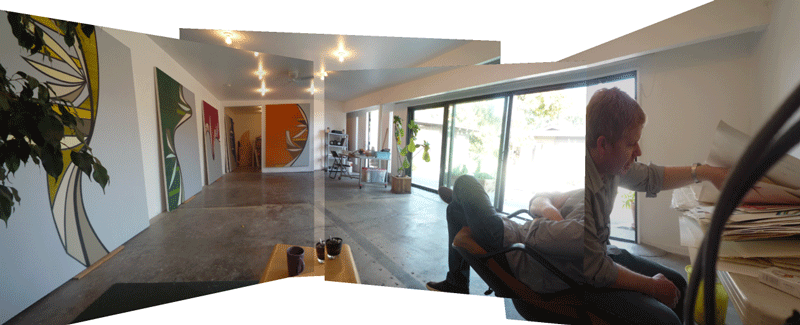
Here's a shot of Bart Exposito's studio three weeks prior to his upcoming show at Thomas Solomon Gallery in Los Angeles.
The five paintings that you can see in this shot are intended to anchor his installation. At the astonishing rate that Bart paints (he kicks my ass in this regard, fluidity, it's a quality that I aspire to), he might create another body of work before the show opens. He's done it already two or three times already. But for now, this is the show that you will see this May 8th.
April 16, 2010
April 14, 2010
Joel Mesler at 30 Orchard, NYC.
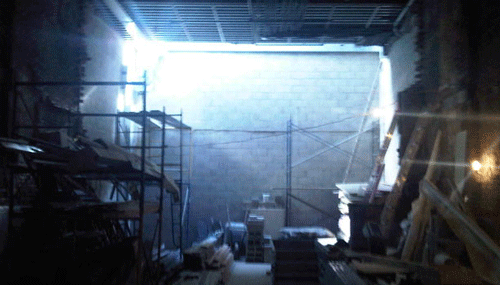
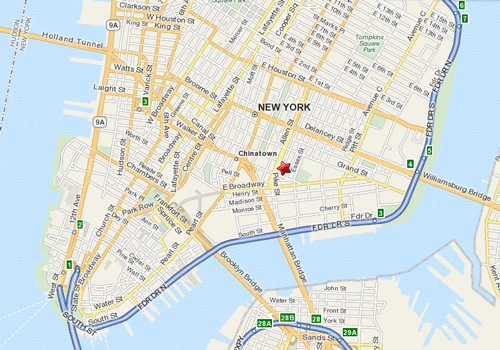
Old friend
Ahora

Among other things, I'm listening to Jeffrey Deitch's interview at Bad at Sports. Interesting stuff, particularly for an Angeleno.
April 13, 2010
De Stijl Life
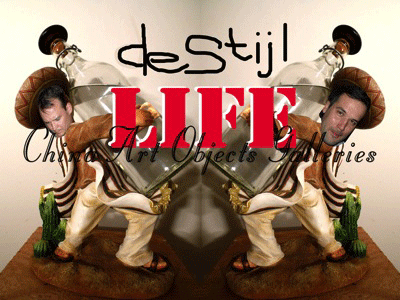
Studio neighbor Adam Janes and Pasadena based artist Eric Pereira collaborated in a duo show at China Art Objects called De Stijl Life. The installation involves mysterious fluids, forgotten artisan craftiness, and a cranky face off between Theo van Doesburg and Piet Mondrian. Next door in China Art Object's bilateral space is an installation of painting and sculpture by Mark Hagen.
I shot a rondo through the opening:
April 12, 2010
Kris Chatterson, James Boulton
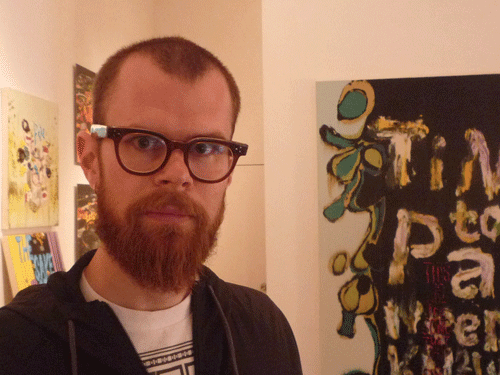
Kris Chatterson, proprietor of KCLOG (and excellent gallery review blog covering young exhibition spaces in Manhattan) dropped in for a visit while he as out from New York to attend a group show that he was included in at Western Projects (gallery) in Culver City. Titled Construction Zone 2010, it opened last week.
(The sculpture in steel -a representation of wood- in the foreground is from Jason Adkins)

Talking to Kris, it was interesting to get an small insight into his paintings in that he is actively using both the plasticity of paint and plasticity of image processing computer programs such as Photoshop. The use of optical equipment in the production of art is as old as the camera obscura, and as common as the presence of overhead projectors that are ubiquitous in artist studios here in Southern California. Kris has achieved a level of fluidity in the use of image processing programs that is worthy of note and it seems to me that his ambition is to merge the two worlds mentioned earlier; on one hand, painting, and on the other, state of the art (image/information manipulation) technology.
Conjoined hands.
His process involves a traditional entry into a painting in acrylic. Images either taken from the painting or imported elsewhere are worked up simultaneously in his computer. Some kind of printing technology tiles up the image from larger files into a mosaic of 8-1/2x11's. The trick is how to get it onto the surface of the painting. First, he flattens his image by overglazing with matt medium, several coats. Then he sands it flat, the medium preserving the state of the painting at this transition. He then adheres the image onto the canvas via some kind of acrylic transfer method (face down in acrylic gel or somesuch). I'm not sure if he repeats this cycle or not, but with a final sealing coat of glaze, the painting is done.
To what end? We talked about Vermeer and the Dutch light, of California Light and Space, and David Reed, and how he was painting from the light of cathode ray tubes. I wouldn't say that Kris Chatterson is painting with a regard for the light emitted from LCD arrays.. but I'd go out on a limb and guess that what he's doing involves the flash of electrons changing the state of bits from one to the other. In this way, I see his paintings flashing likewise.
After the visit, we dropped in next door to see a show that was being taken down...
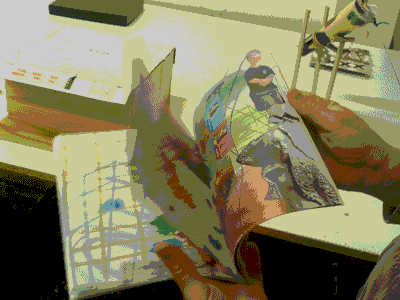
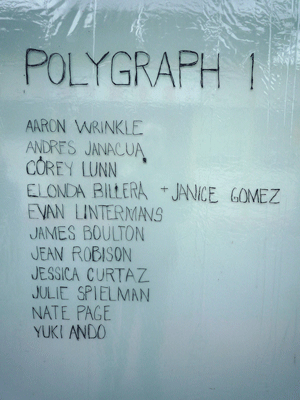
My neighbor Evan Lintermans cleared out his studio to have a one night show.
John Boulton published a limited edition book, a collage of images, and handed our ten of them to ten friends and asked them to alter it as they pleased. the space was cleaned up, and a show installed in an afternoon. A barrel of beer and a night of bonhomie.

(I was a bit sloppy in shooting fotos, some artists aren't represented in the collage above.)
A polygraph? A lie detector? One administered to friends and acquaintances? Polygraph technology assumes a baseline of information and a series of questions designed to evoke a response or a lack of one. Information flows and characters revealed. Well, that's a fine premise for a group show, isn't it?
April 11, 2010
April 8, 2010
a crack in the glass of a window
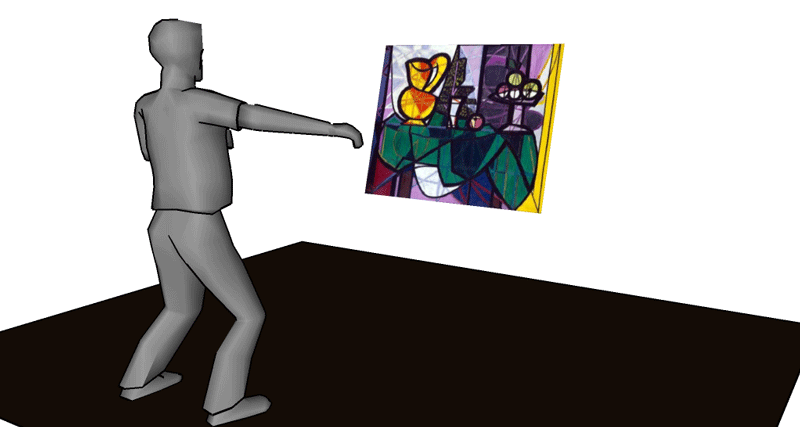
Nice.
Tyler Green and Ed Schad have an interesting conversation, here's part of Tyler Green's intro:
The Guggenheim is having a much more modest Picassopalooza: It is showing two great still-lifes as part of a seventh-floor collection installation: This great 1924 painting that was the partial subject of one of TJ Clark's 2009 Mellon Lectures and the painting here, 1931's Pitcher with Bowl of Fruit. I saw the painting on a GuggWander with my buddy Ed Schad, who writes the blog I call it ORANGES, for Art Slant and ArtReview, and who works for the Broad Art Foundation. Ed and I were fascinated by the painting so I thought I'd try something new here on MAN: An in-depth conversation focused on one artwork. This is part one of two, published pretty much just as Ed and I talked it out -- no self-puffing editing involved. (Part two is here.):
Another thought:
TG: What if I put it this way: Picasso and Braque undertook a great experiment to destroy objects, to take them apart via cubism. The result of that experiment was to destroy the actual objects and to create new ones: Paintings. Meyer Schapiro says that before cubism there were paintings of things. After cubism, paintings were things.And now, perhaps paintings are both things and of things.
Are/Of.
Of/Are.
Space/Time.
Palm of the hand./Back of the hand.
Pedestrian Cities/Car Cities.
Democrat/Republican.
Reality/Illusion.
Absolute/Relative.
Abstraction/Representation.
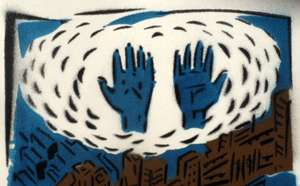
April 7, 2010
Mark Grotjahn, BadAss.

Henry and I visited the Mark Grotjahn solo show at Blum and Poe Gallery in Culver City in the last week before the show came down. Grotjahn has always been impressive and now even more so since his work has taken a turn... a huge shift in what is popularly known as a change in practice from abstraction to figuration. But then one could make an argument that his painterly language has been nearly the same, that it is just that his formalistic rigor has been unbound. The inside scoop is that he has always begun his work with figuration (faces, I think) and during his previous epoch, he was overlaying his signature ray shots over, eventually obliterating or concealing what might be called portraiture. (You can check out his earlier work here.)
I think that even in his geometric abstractions, he implied facial/bodily imagistics with a slight dislocation, a kind of contrapposto, the eventual migration of bilateral symmetry that moves from godly perfection to the all too human. Another indication of figuration.
All that is cool, but what really punches me in the gut about this show is the material bad-assed-ness of it all. One, two, three, four dimensions of paint handling... but not much more. Brushes, maybe palette knives, card board... cardboard!.... glued onto linen strung over stretcher bars and sliced and torn away. Hatches and lines, lines layered like his earlier work, providing continuity. Some say they see Picasso, others Klee. His name is signed into the lower right hand corner and repeated over and over along the edges, buried and exhumed on the flatlands. His name sprayed like a wild dog marking his territory. There's a kind of recursiveness in how his themes and facture fold in on itself, compounding itself until the layers stack up like a fugue.
A fugue that can handle itself in a bar fight, that is.
This show was simultaneously an inspiration and a challenge. It's what one hopes for when you haul ass out over a city like LA, looking at a sea of art that tends to look too much like everything else. A show like this summons the urgent need to get back in the studio post haste, that strange feeling of simultaneously wanting to stay and soak it up and get your butt out of there, back into the studio and get to work.
For a conventional view of the exhibition, click here to view installation views and individual paintings in the show. This blogpost is for my friends who couldn't get to the show, nearly thirty details in the pop up images tiled thumbnails below.
Click away:
April 6, 2010
"BOY"

At Peres Projects, Cody Critcheloe figures life is a party. Here is the first chunk of their press release:
SSION
"BOY"
Peres Projects, Los Angeles
January 16 ? April 3, 2010Press Release:
Javier Peres is very pleased to present "BOY", the first Los Angeles solo exhibition by Cody Critcheloe ? SSION (B. Kentucky USA. Lives and work in Kansas City, MO). "BOY" brings together nine separately shot but jointly conceived music videos for SSION's 2007 record Fool's Gold.
First things first! It's SSION, pronounced "shun," as in mission, fission, ambition-all apt words to describe the gesamtkunstwerk that is Cody Critcheloe and the queer punk/performance/art band he invented ten years back as a high school student in Lewisport, Kentucky. In the time since then, SSION has released 4 full-length records, toured extensively through the United States, and enjoyed cult status among fans and music writers who have lauded Critcheloe as everything from Out magazine's Hottest Artist of the Year to "Prince's love child" to the "one true master" of "high-concept sleaze pop."
The Peres website has a walk through video, but I prefer my 30 second rotation:
By the way, Peres has a great staff there, good people, muy amable.
Michael Reafsnyder at Western Projects
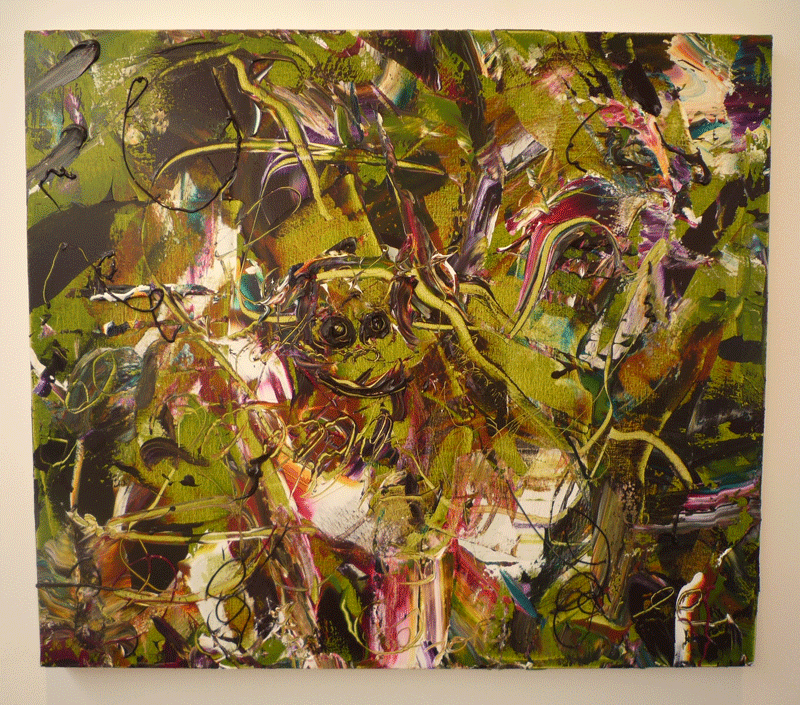
Michael Reafsnyder has just closed his show at Western Projects in Culver City. He got some good press along the way.
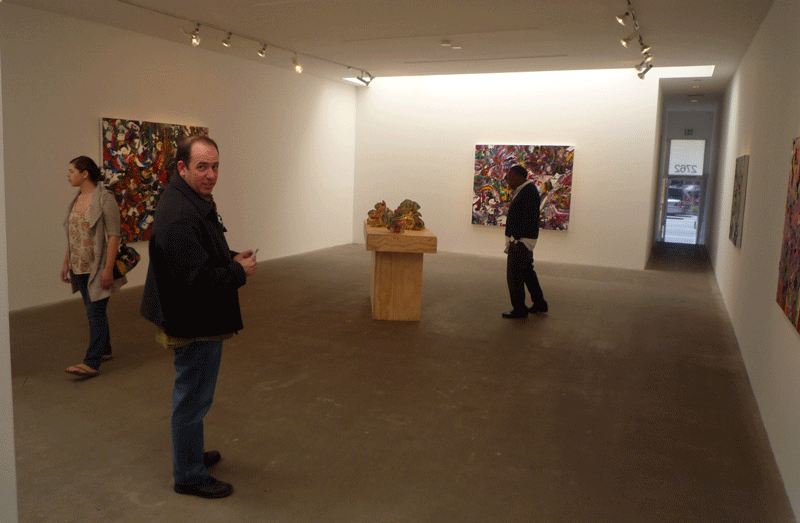
His show balanced his sculpture (ceramics) with his painting. The shift from painting to sculpture is a tricky move and Michael found the kind of resonance in media that is natural and consonant in terms of his vision and material handling, a tough thing to do. Painting with Gamblin colors, he too paints alla prima, as I do... but much more ferociously. Where I take up to a week to guide a painting to completion, he bears down hard in a single day for each one. Hard core.
Here are a few close ups to get in on his facture dynamics:
